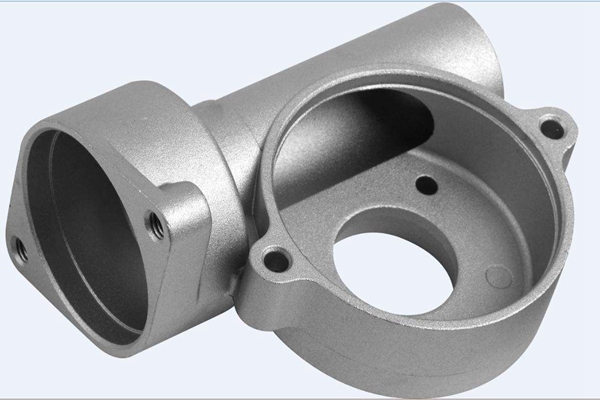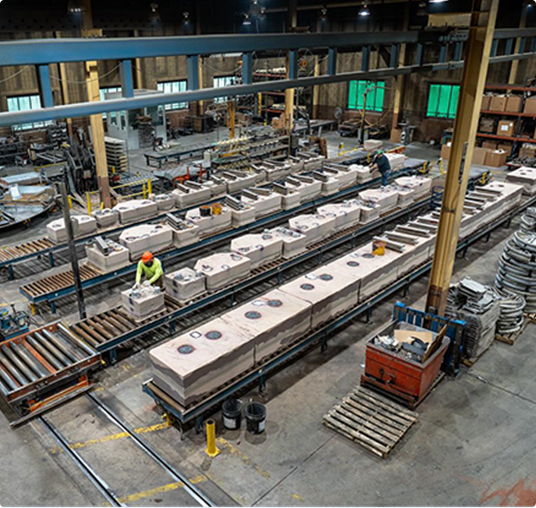How Metal Castings support innovation in different industries
Everything About Light Weight Aluminum Castings: Recognizing Their Duty and Importance in Manufacturing
Aluminum spreadings are important to modern production, supplying a blend of light-weight residential properties and sturdiness. They facilitate complex styles while minimizing setting up costs. Industries such as aerospace and automobile regularly use these elements for improved efficiency. The manufacturing of light weight aluminum castings is not without its challenges. Understanding the nuances of this procedure reveals both the benefits and potential pitfalls. Exploring these factors will certainly supply deeper insights right into their expanding value.
Summary of Aluminum Spreading Processes
Light weight aluminum casting processes play an essential duty in production, using versatility and performance. These processes include putting liquified aluminum right into molds to create specific forms and elements. Numerous strategies are utilized, consisting of sand casting, pass away casting, and investment spreading, each differentiated by its method of mold development and the designated application.
Sand casting uses a mixture of sand and binder to form molds, permitting intricate geometries. Pass away spreading, on the various other hand, includes forcing liquified aluminum right into steel mold and mildews, resulting in high accuracy and smooth coatings. Investment spreading, frequently used for intricate styles, involves producing a wax pattern covered with a ceramic covering, which is after that filled up with liquified light weight aluminum.
These casting methods accommodate varied commercial demands, making aluminum a recommended product for parts in markets such as automobile, aerospace, and durable goods. The selection of casting technique greatly affects the final item's quality and performance.
Benefits of Using Aluminum Castings
The advantages of using aluminum castings in production are substantial and numerous. To begin with, light weight aluminum's lightweight nature adds to decreased overall item weight, improving energy performance in applications such as aerospace and auto industries. Additionally, aluminum spreadings show outstanding rust resistance, guaranteeing durability and resilience in extreme environments. The product's thermal and electrical conductivity also makes it suitable for various applications, consisting of electronics and warm exchangers.
Furthermore, light weight aluminum castings can be produced with elaborate styles, enabling extra intricate shapes that fulfill particular useful demands. This flexibility adds to lowered setting up expenses and boosted layout versatility. In addition, the spreading process itself is effective, enabling for high-volume manufacturing with regular high quality. Aluminum is recyclable, making it an environmentally pleasant choice in production. Jointly, these benefits highlight why aluminum castings are increasingly preferred throughout diverse industries, providing both performance advantages and financial efficiency.
Typical Applications of Light Weight Aluminum Castings
While different materials are utilized in production, aluminum castings stand apart as a result of their wide variety of applications across multiple sectors. These castings are extensively used in the automobile sector for engine elements, transmission real estates, and structural parts, adding to lighter automobiles and enhanced gas effectiveness. In the aerospace market, light weight aluminum spreadings are important for aircraft elements, where weight decrease is essential for efficiency and security.
Additionally, the electrical market uses light weight aluminum castings for housings and structural components in machinery, taking advantage of the product's excellent conductivity. In consumer products, light weight aluminum spreadings can be located in items such as appliances and showing off tools, supplying longevity and a contemporary visual. In addition, the building industry utilizes light weight aluminum castings in architectural aspects, window frames, and fixtures, showcasing their flexibility and stamina. Generally, aluminum castings play an essential function in improving product efficiency and efficiency throughout numerous fields.
Secret Production Techniques for Light Weight Aluminum Castings
The manufacturing of light weight aluminum spreadings relies upon different methods, with sand casting and die spreading being amongst one of the most prominent. Sand casting involves developing mold and mildews from sand, enabling for huge components and elaborate layouts. In comparison, pass away casting makes use of high-pressure shot of molten aluminum right into recyclable molds, offering accuracy and performance for mass manufacturing.
Sand Spreading Refine
Sand casting stands as one of the most extensively used techniques for generating light weight aluminum spreadings, thanks to its convenience and cost-effectiveness. This process includes developing a mold from a combination of sand and a bonding agent, normally clay. Once the mold and mildew is ready, liquified light weight aluminum is put right into it, enabling the steel to fill the dental caries. After cooling down, the mold is escaped to reveal the spreading. Sand casting fits intricate geometries and big components, making it ideal for various applications. Additionally, it permits easy modifications, allowing manufacturers to readjust designs promptly. Nonetheless, the surface coating may need added machining for specific applications, guaranteeing the end product fulfills top quality standards.
Pass Away Spreading Methods
Die casting represents an extremely effective technique for generating aluminum spreadings, identified by its capability to provide high accuracy and superb surface area coating. This strategy largely entails compeling molten aluminum into a mold and mildew under high pressure, ensuring that complex forms and fine information are recorded properly. There are two main die spreading approaches: warm chamber and chilly chamber. Hot chamber pass away spreading appropriates for alloys with reduced melting factors and permits faster cycles, while cold chamber pass away casting is ideal for high-temperature alloys, calling for separate melting systems. Both approaches improve manufacturing rates and minimize material waste, making die casting a recommended choice in sectors such as vehicle and electronics, where sturdiness and dimensional accuracy are critical.
Sustainability in Aluminum Casting Production
While the need for light weight aluminum spreadings continues to grow, makers are increasingly prioritizing sustainability in their manufacturing procedures. This shift is driven by the requirement to lower environmental influence and conserve natural resources. Several firms are embracing recycling efforts, utilizing scrap light weight aluminum, which especially reduces energy intake and greenhouse gas discharges contrasted to key light weight aluminum manufacturing. Furthermore, innovations in casting modern index technologies are enabling extra effective use materials, minimizing waste during the production procedure.
Manufacturers are also checking out environmentally friendly options to conventional spreading methods, such as 3D printing and advanced mold innovations, which aid optimize resource usage. Metal Castings. On top of that, applying lasting techniques in supply chain monitoring guarantees that resources are sourced responsibly. Consequently, the aluminum spreading industry is making strides towards a much more sustainable future, lining up with worldwide environmental goals while satisfying the enhancing need for high-performance aluminum products
Difficulties and Considerations in Aluminum Casting
Light weight aluminum casting presents various obstacles that suppliers need to navigate to assure item integrity. Style intricacy can make complex the spreading process, bring about possible problems and raised manufacturing time. Furthermore, keeping rigorous top quality control requirements is important to meet the demands of precision and integrity in ended up parts.

Layout Complexity Issues
Designing parts for aluminum casting presents various intricacies that engineers have to navigate to attain ideal outcomes. One significant difficulty is the need for precise geometry; detailed styles can bring about problems in mold development and increased threat of issues. Additionally, thermal residential properties of aluminum require cautious consideration of cooling down rates, as unequal cooling can trigger warping. Wall surface density variations additionally posture an obstacle, as they can impact circulation features and structural integrity. Engineers have to stabilize layout aesthetic appeals with manufacturability, ensuring that attributes such as ribs and fillets are maximized for stamina without complicating the spreading procedure. Lastly, considerations pertaining to draft angles are important to help with mold and mildew release, more making complex the design process. These factors jointly underscore the intricacies entailed in aluminum spreading layout.
Quality Assurance Difficulties
Accomplishing top notch light weight aluminum spreadings includes navigating a variety of quality assurance obstacles that can significantly impact the last product. Variations in raw material composition can lead to incongruities in casting properties, making it essential to assure worldly top quality. Second, the spreading procedure itself is prone to defects, such as porosity and shrinking, which can compromise structural integrity. In addition, temperature control during melting and pouring is vital; variations can cause unequal solidification, impacting dimensional accuracy. Detailed evaluation methods, consisting of non-destructive screening, need to be used to recognize flaws early. Finally, preserving rigorous procedure documentation and adherence to industry requirements is vital for traceability and top quality assurance, highlighting the elaborate equilibrium called for to create reliable light weight aluminum spreadings in production.
Future Trends in Aluminum Casting Modern Technology
As manufacturers strive to improve effectiveness and sustainability, developments in light weight aluminum spreading technology are emerging to meet these demands. One considerable pattern is the integration of automation and synthetic intelligence, which enhance production procedures and enhance precision in casting operations. These improvements reduce human error and enhance resource usage, inevitably causing set you back reductions.
Furthermore, the adoption of innovative materials and alloys is improving the landscape. New solutions enhance efficiency characteristics, such as deterioration resistance and lightweight residential properties, making aluminum spreadings much more flexible throughout different sectors.
Lasting methods are gaining grip, with an emphasis on recycling and lessening waste (Wisconsin Aluminum Foundry). Techniques such as 3D printing are likewise being checked out to produce complicated geometries that were formerly unattainable
Often Asked Inquiries

Just How Do Aluminum Castings Contrast to Various Other Materials?
Light weight aluminum spreadings offer advantages such as light-weight, deterioration resistance, and outstanding thermal conductivity compared to other materials. They are typically chosen for applications needing resilience and performance, especially in aerospace find and vehicle markets.
What Is the Life-span of Aluminum Castings?
The life expectancy of light weight aluminum spreadings normally ranges from 10 to 50 years, depending upon environmental conditions, usage, and maintenance. Their corrosion resistance and durability add significantly to their long-lasting performance in various applications.
Can Aluminum Castings Be Recycled?
Yes, light weight aluminum spreadings can be recycled. The recycling procedure is reliable, allowing for the healing of light weight aluminum without considerable loss of quality, making it a sustainable option in manufacturing and decreasing environmental influence.
What Safety Procedures Are Needed During Aluminum Casting?
During light weight aluminum spreading, essential security measures include putting on suitable individual protective tools, making certain appropriate ventilation, preserving devices, making use of fire-resistant products, and carrying out secure managing methods for molten metal to stop mishaps and injuries.
Exactly How Do Temperature Level Changes Affect Aluminum Castings?
Temperature level changes considerably influence aluminum spreadings by pop over to this web-site influencing fluidity, solidification prices, and mechanical residential or commercial properties. Rapid cooling can result in enhanced brittleness, while steady air conditioning advertises far better structural stability and decreases the danger of flaws.
Pass away casting, on the other hand, includes requiring molten aluminum into steel mold and mildews, resulting in high accuracy and smooth coatings. The production of light weight aluminum castings relies on numerous strategies, with sand casting and pass away spreading being among the most noticeable. Sand spreading stands as one of the most widely utilized techniques for creating aluminum spreadings, many thanks to its convenience and cost-effectiveness. Pass away casting represents a highly efficient technique for producing aluminum castings, characterized by its ability to deliver high precision and excellent surface coating. While the demand for aluminum spreadings proceeds to expand, suppliers are increasingly focusing on sustainability in their manufacturing procedures.